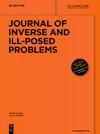脑成像反演问题的层电位方法
IF 0.9
4区 数学
Q2 MATHEMATICS
引用次数: 0
摘要
摘要利用立体脑电图(sEEG)在脑内点方向测量的电势、脑电图(EEG)在头皮上点方向测量的电势或脑磁图(MEG)在脑外点方向测量的磁通量密度,研究了逆源定位问题。我们提出了一种适用于各种初级电流模型的方法;特别是,我们给出了假定为平滑矢量场的初级电流的细节,这些矢量场支持并通常面向灰质/白质界面。无论使用何种数据,我们还解决了与回收源相关的电位传输问题;因此我们解决了皮质映射问题。为保证电势和正常电流在磁头内连续,电势用双层电势的线性组合表示,磁通密度用单层电势的线性组合表示。在数值上,我们解决了灰质/白质界面、皮质表面、颅骨和头皮的网格面问题。我们采用的数值方法的一个主要特点是,在网格表面上,我们可以精确地计算任意点的双层和单层电势。由于我们在使用磁数据时明确地研究了磁头电势的传输,从而明确了源恢复问题中电、磁数据的耦合,显示了同时使用电、磁数据的优势。我们提供了使用合成数据的源恢复和逆皮质映射的数值示例。本文章由计算机程序翻译,如有差异,请以英文原文为准。
A layer potential approach to inverse problems in brain imaging
Abstract We study the inverse source localisation problem using the electric potential measured point-wise inside the head with stereo-ElectroEncephaloGraphy (sEEG), the electric potential measured point-wise on the scalp with ElectroEncephaloGraphy (EEG) or the magnetic flux density measured point-wise outside the head with MagnetoEncephaloGraphy (MEG). We present a method that works on a wide range of models of primary currents; in particular, we give details for primary currents that are assumed to be smooth vector fields that are supported on and normally oriented to the grey/white matter interface. Irrespective of the data used, we also solve the transmission problem of the electric potential associated with a recovered source; hence we solve the cortical mapping problem. To ensure that the electric potential and normal currents are continuous in the head, the electric potential is expressed as a linear combination of double layer potentials and the magnetic flux density is expressed as a linear combination of single layer potentials. Numerically, we solve the problems on meshed surfaces of the grey/white matter interface, cortical surface, skull and scalp. A main feature of the numerical approach we take is that, on the meshed surfaces, we can compute the double and single layer potentials exactly and at arbitrary points. Because we explicitly study the transmission of the electric potential in head when using magnetic data, the coupling of electric and magnetic data in the source recovery problem is made explicit and shows the advantage of using simultaneous electric and magnetic data. We provide numerical examples of the source recovery and inverse cortical mapping using synthetic data.
求助全文
通过发布文献求助,成功后即可免费获取论文全文。
去求助
来源期刊

Journal of Inverse and Ill-Posed Problems
MATHEMATICS, APPLIED-MATHEMATICS
CiteScore
2.60
自引率
9.10%
发文量
48
审稿时长
>12 weeks
期刊介绍:
This journal aims to present original articles on the theory, numerics and applications of inverse and ill-posed problems. These inverse and ill-posed problems arise in mathematical physics and mathematical analysis, geophysics, acoustics, electrodynamics, tomography, medicine, ecology, financial mathematics etc. Articles on the construction and justification of new numerical algorithms of inverse problem solutions are also published.
Issues of the Journal of Inverse and Ill-Posed Problems contain high quality papers which have an innovative approach and topical interest.
The following topics are covered:
Inverse problems
existence and uniqueness theorems
stability estimates
optimization and identification problems
numerical methods
Ill-posed problems
regularization theory
operator equations
integral geometry
Applications
inverse problems in geophysics, electrodynamics and acoustics
inverse problems in ecology
inverse and ill-posed problems in medicine
mathematical problems of tomography
 求助内容:
求助内容: 应助结果提醒方式:
应助结果提醒方式:


